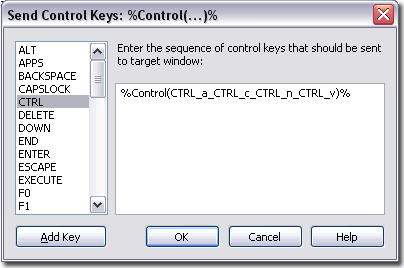Sending control key presses
This macro is used to send presses of control keys into the destination window. You can use it for "pressing" single keys, e.g. Tab, Enter, Escape or more complex combinations. Flashpaste does not pretend to replace special software for macro recording and playback; there are many actions which cannot be "programmed" using Flashpaste. However, you can use %Control(...)% to perform simple macros to save your time.
You can add macros into your text using the main menu of the configuration window String -> Insert Macros -> Send Control Keys... or write them manually in the line body.
Usage
The macro body is located in brackets and represents a sequence of commands separated by the underscore: %Control(x_x_x_x)%, where x is one of supported instructions. As a command you can use the following:

- Key identifier - tab, enter, ctrl... You can quickly insert the identifier using the list in the Add Control Macro dialog (see the picture above).
- Key letter - o, s, n. This way, you can for example access a menu item using the alt_n sequence or invoke the file open dialog using the ctrl_o sequence.
- Key letter after '^' symbol - ^o, ^s, ^n. This is alternative method to send key pressing as a UNICODE character. This works better then simply "o" or "s" in some applications. You are welcome to experiment on.
- Key code - #49, #1065. You will probably never have to use keycodes, however it is possible.
- Pause command: @time - @250, @1000. Specify the length of pause in milliseconds after the @ character.
- Repeat command - You can repeat pressing of any key N times by specifying *N after it. For example, left*3 will move the cursor 3 points left.
Specifics
- %Control(...)% is not case-sensitive, i.e. %Control(tab)% is identical to %CONTROL(TAB)%.
- You can "accumulate" modifier keys - for example, to press ctrl+shift+p use %Control(ctrl_shift_p)%
- The sequence of modifier keys is applied only to the first character which follows it. If you need to press alt+n, alt+k use %Control(alt_n_alt_k)%, instead of %Control(alt_n__k)%.
- As a rule, to press the ALT, the alt command suffices, but in some cases you have to emulate exactly the right or left ALT, in this case you can use Ralt or Lalt respectively.
- If you need to send a long sequence of keys and the application can't process them all, try to use a pause (@500).
- In theory you can try to print characters using this macro, for example the %Control(t_e_s_t)% macro can print the "test" line, but in reality the result may be not what you intended. Better use %Print(test)% instead.
- Note: Flashpaste uses global hotkey to quickly insert the last inserted line; by default it is Ctrl+O though you could reconfigure it. Don't use this combination in your macros or the program could hang.
Simple examples
- MyLogin%Control(tab)%MyPassword%Control(enter)% - example which fills a login form. Insert MyLogin, proceed to the next field, insert MyPassword and press Enter. (Note that it could be better to use %Print(MyLogin)% and %Print(MyPassword)%).
- %Control(alt_l_y_d_enter)% - this is an easy way to add Drop Shadow for the current layer in Photoshop.
- %Control(ctrl_a_ctrl_c_ctrl_n_ctrl_v)% this macro, launched in Word will open a new document and copy to it all text in the current file.
Reserved keywords
APPS, BACKSPACE, CAPSLOCK, DELETE , DOWN, END, ENTER, ESCAPE, EXECUTE, F0, F1, F11, F12, F2, F3, F4, F5, F6, F7, F8, F9, HOME, INSERT, LEFT, LSTARTMENU, PAGEDOWN, PAGEUP, PRINTSCREEN, RIGHT, RSTARTMENU, SPACE, STARTMENU, TAB, UP,
Modifier keys
ALT, CTRL, LALT, LCTRL, LSHIFT, LWIN, RALT, RCTRL, RSHIFT, RWIN, SHIFT, WIN
Intro
Work with program
Macros